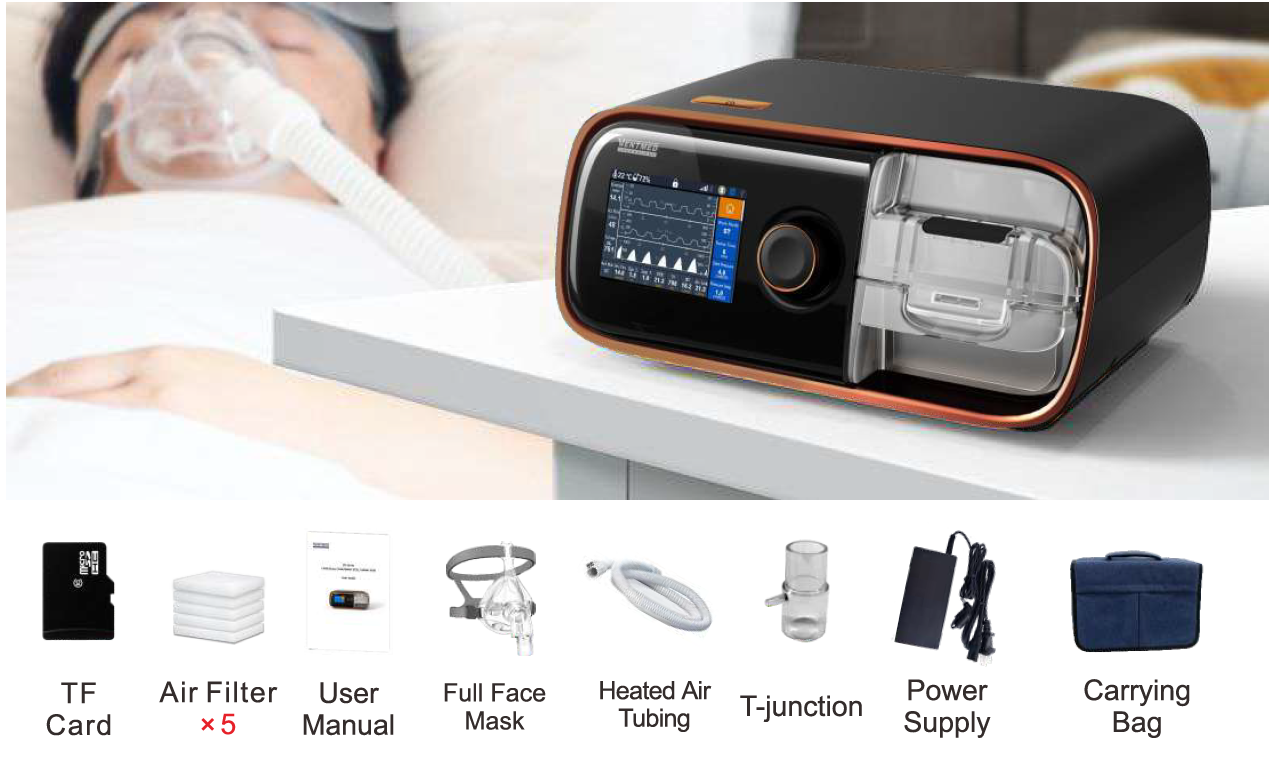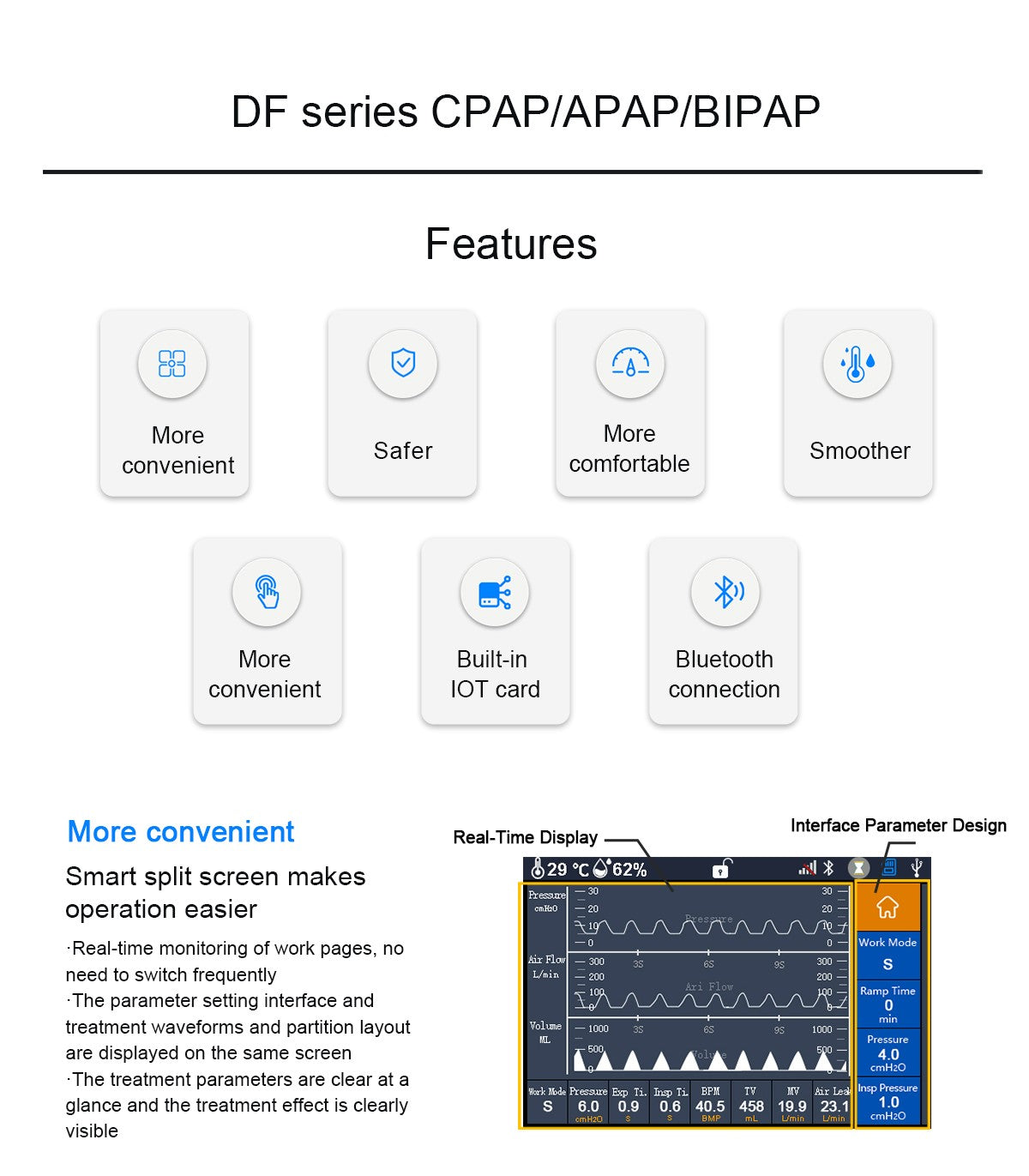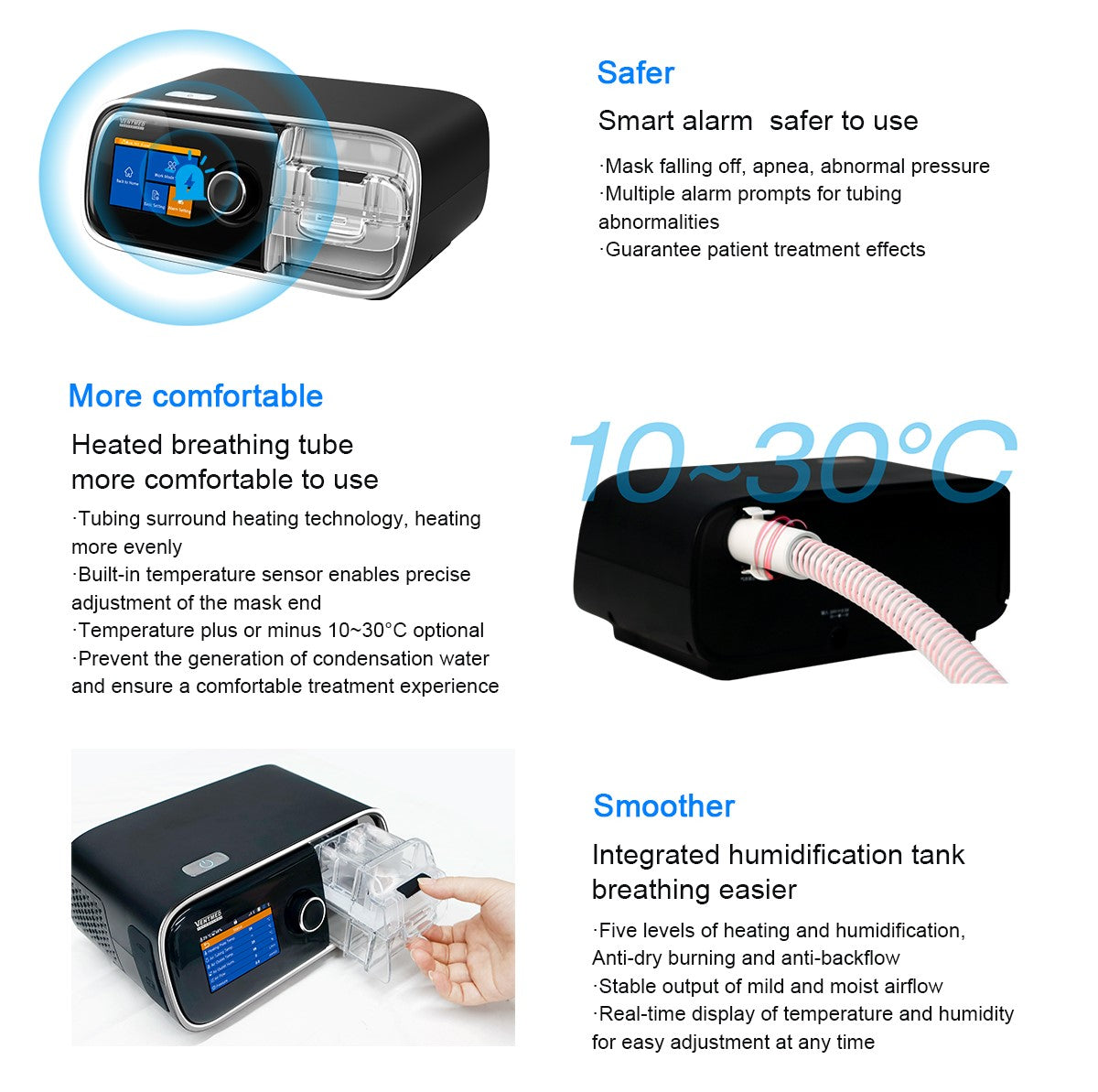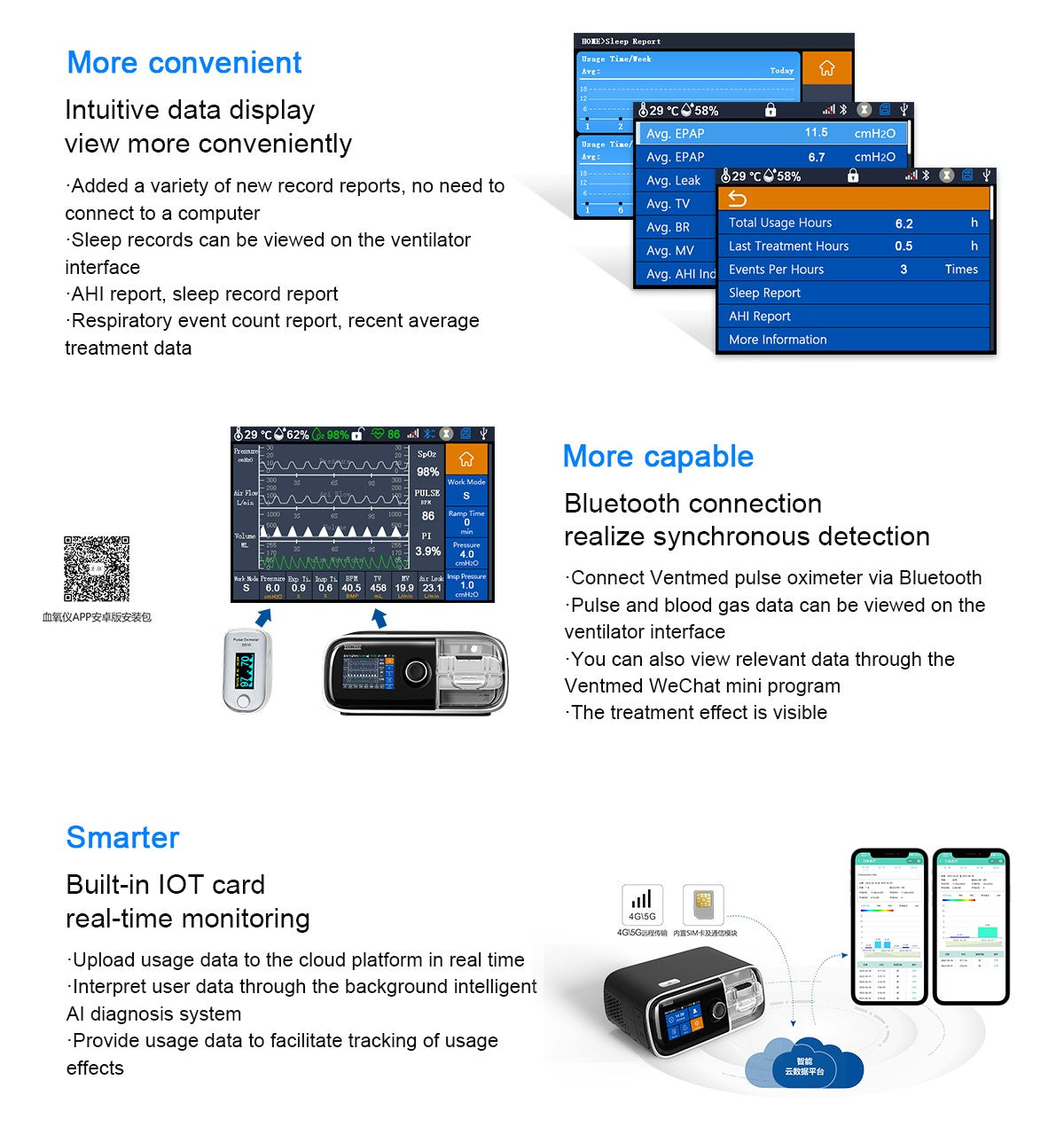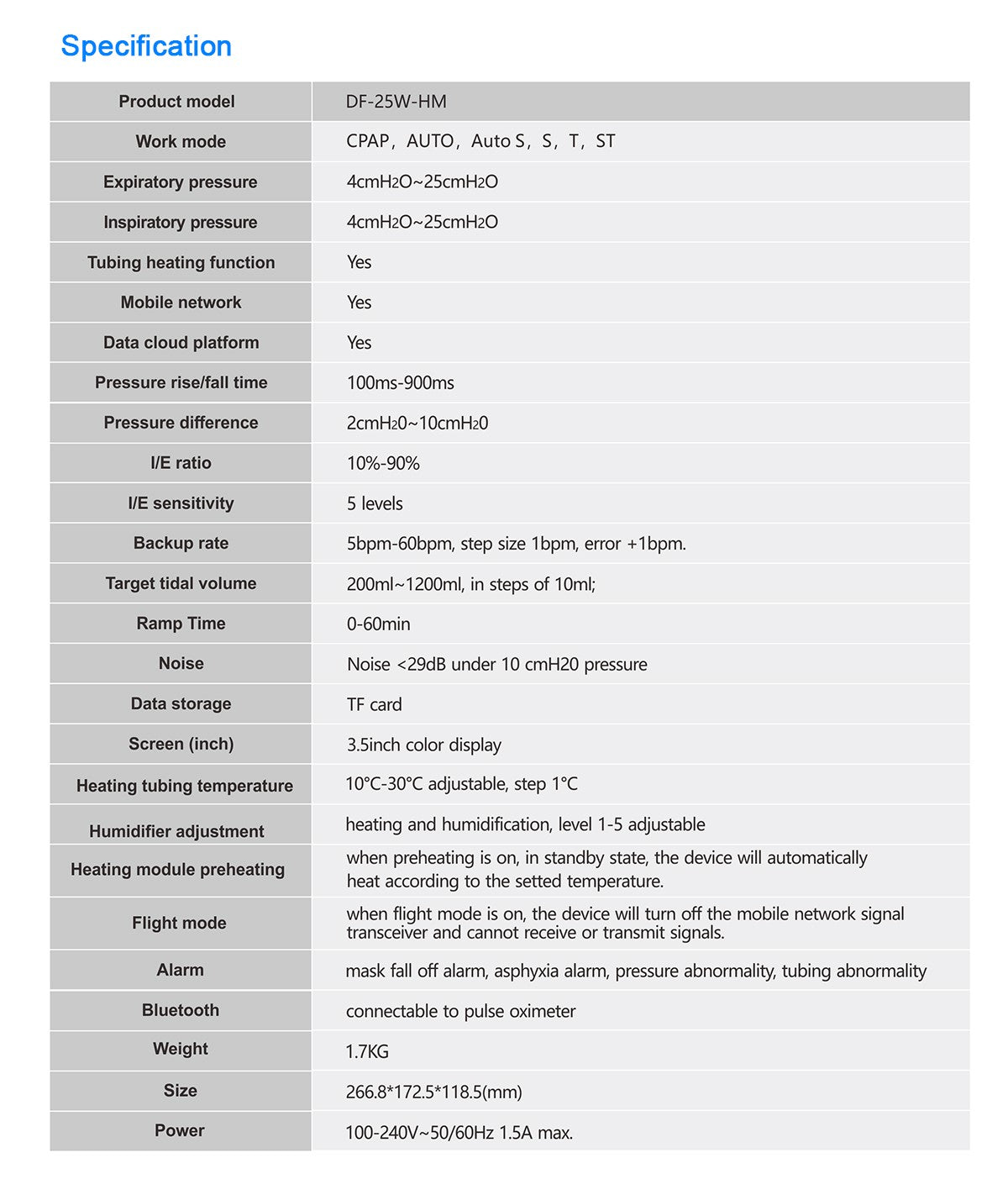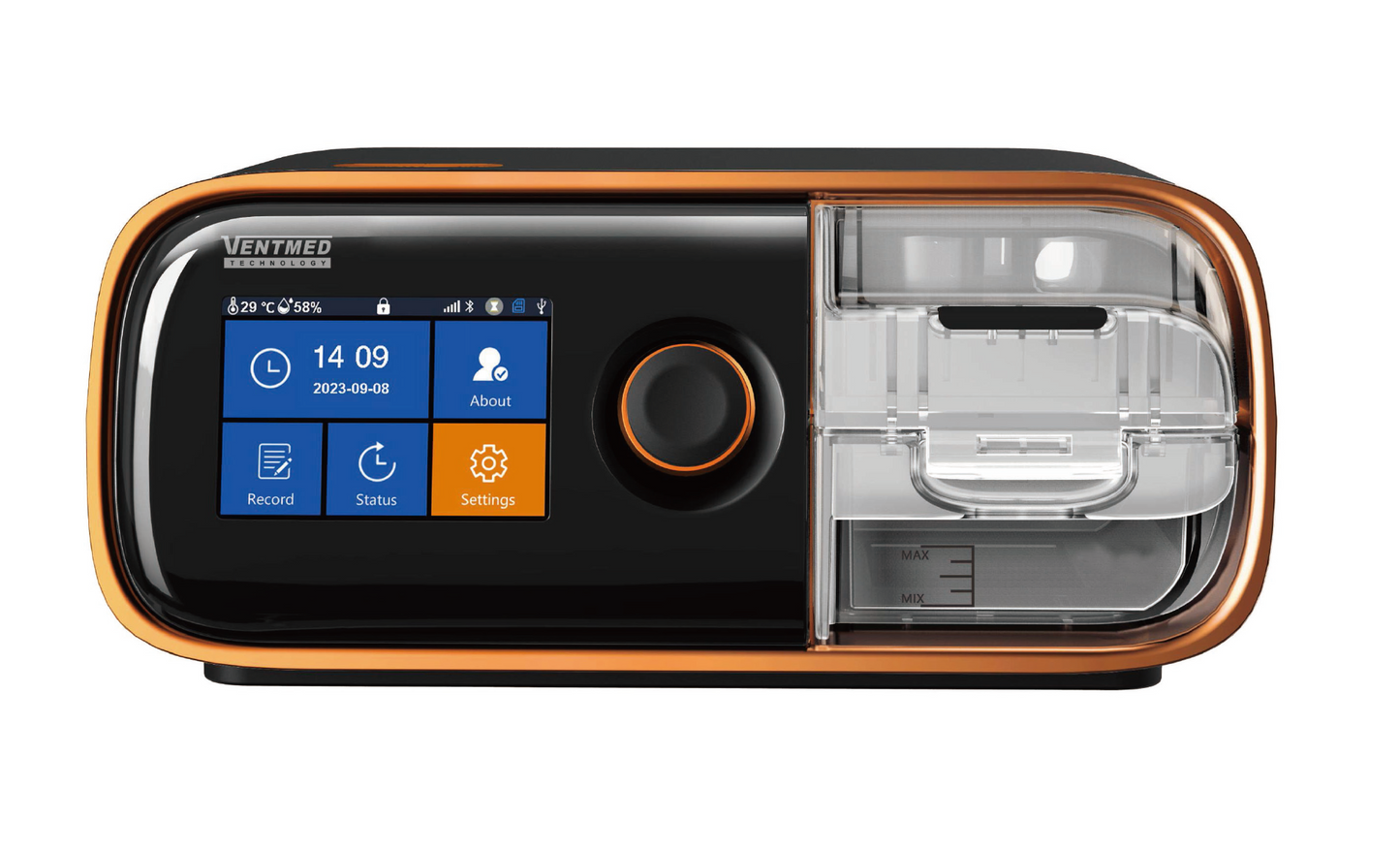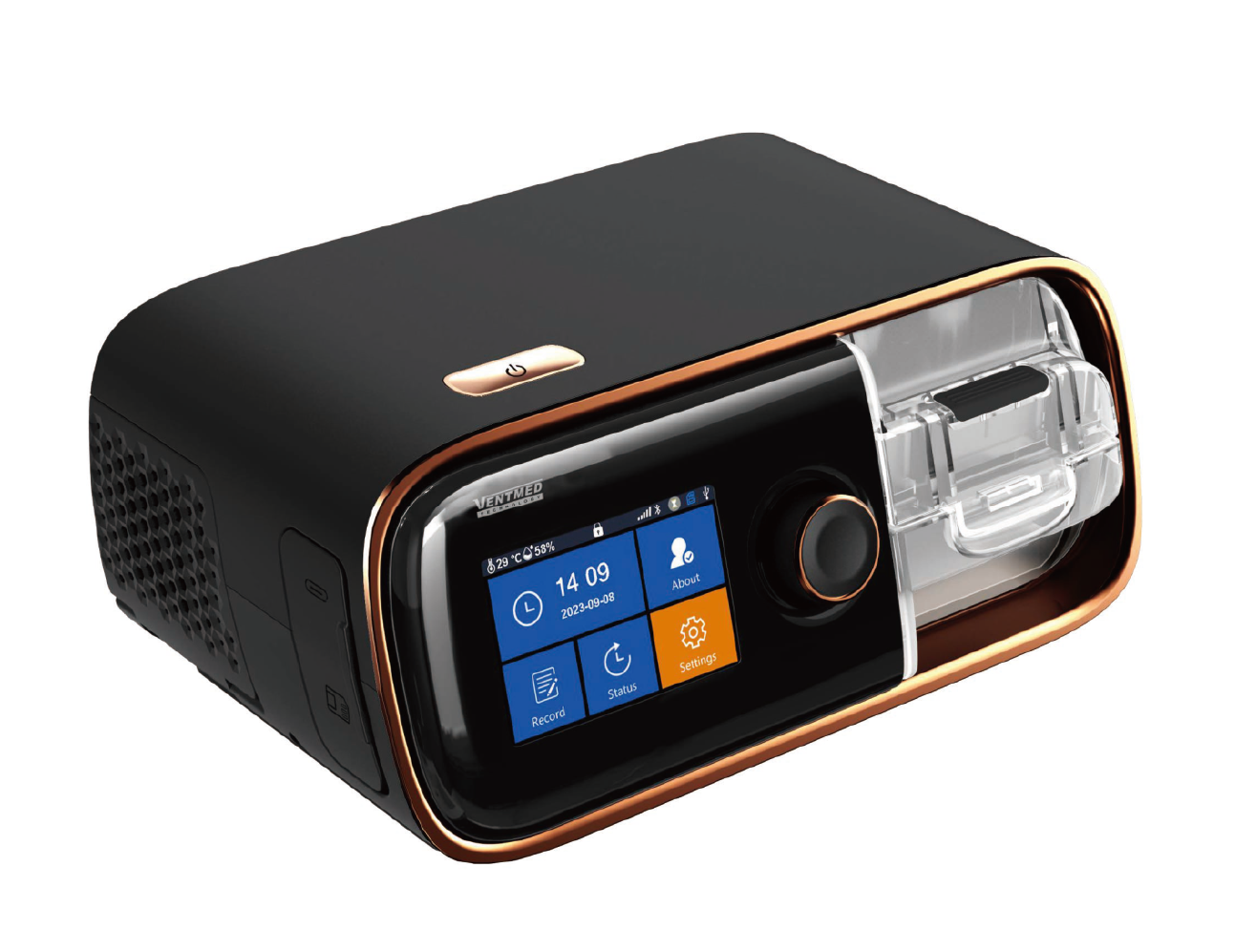VentMed
Ventmed DF-25W-HM BiPap Machine with Heated Tubing
Ventmed DF-25W-HM BiPap Machine with Heated Tubing
Kaore i taea te uta i te wateatanga tiki
Ventmed DF-25W-HM BiPAP Machine
The Ventmed DF-25W-HM BiPAP machine is designed for the treatment of adult patients with sleep apnea, COPD, and obesity hypoventilation syndrome, suitable for both home and hospital use.
Features:
-
Enhanced Safety and Comfort:
- Improved safety mechanisms
- Smoother operation
- Enhanced user comfort
-
Advanced Connectivity:
- Bluetooth connection
- SIM card compatibility (not tested in New Zealand)
-
User-Friendly Interface:
- Real-time display with smart split-screen technology for easy monitoring and operation
- Simultaneous display of treatment parameters and waveforms
-
Comfortable Breathing Experience:
- Heated breathing tube with surround heating technology for an evenly heated and comfortable airflow
- Built-in temperature sensor with precise adjustment options (±10~30°C) to prevent condensation
-
Data and Monitoring:
- Intuitive data display for easy viewing of sleep records, AHI reports, and respiratory event counts without needing a computer
- Built-in IoT card reader for real-time data upload and monitoring via a cloud platform, with AI diagnosis for user data interpretation (this feature may not be available in New Zealand yet)
- Micro SD card and software included to view sleep compliance reports
-
Smart Alarms:
- Multiple alarms for mask detachment, apnea, abnormal pressure, and tubing issues to ensure treatment efficacy
-
Integrated Humidification:
- Five levels of heating and humidification
- Anti-dry burning and anti-backflow features
- Real-time temperature and humidity display for easy adjustment
-
Compatibility and Convenience:
- Bluetooth connectivity for pulse oximeter integration, allowing pulse and blood gas data viewing on the ventilator interface or via the Ventmed WeChat mini program
- Various new record reports viewable on the ventilator interface
Specifications:
- Product Model: DF-25W-HM
- Work Modes: CPAP, AUTO, Auto S, S, T, ST
-
Pressure Ranges:
- Expiratory: 4cmH2O~25cmH2O
- Inspiratory: 4cmH2O~25cmH2O
- Tubing Heating Function: Yes
- Mobile Network Compatible: Yes
- Pressure Rise/Fall Time: 100ms-900ms
- Pressure Difference: 2cmH20~10cmH20
- Data Cloud Platform: Yes
- I/E Ratio and Sensitivity: Adjustable
- Backup Rate: 5bpm-60bpm (step size 1bpm, error +1bpm)
- Target Tidal Volume: 200ml~1200ml (steps of 10ml)
- Ramp Time: 0-60min
- Noise Level: <29dB under 10 cmH2O pressure
- Data Storage: TF card
- Screen: 3.5-inch color display
- Heating Tubing Temperature: 10°C-30°C adjustable (step 1°C)
- Humidifier Adjustment: Level 1-5 adjustable
- Heating Module Preheating: Automatically adjusts during standby
- Flight Mode: Disables mobile network signals
- Alarms: Mask detachment, asphyxia, pressure abnormalities, tubing issues
- Weight: 1.7KG
- Dimensions: 266.8172.5118.5(mm)
- Power: 100-240V~50/60Hz 1.5A max
Operation Modes:
Auto CPAP mode adjusts pressure levels automatically throughout the night. This mode is primarily used to treat conditions that involve fluctuating airway obstructions and varying pressure requirements. The conditions commonly treated with Auto CPAP mode include:
-
Obstructive Sleep Apnea (OSA): Auto CPAP is particularly beneficial for patients with OSA, as it automatically adjusts the pressure to keep the upper airway open, reducing apneas, hypopneas, and snoring.
-
Upper Airway Resistance Syndrome (UARS): Although less severe than OSA, UARS involves increased resistance in the upper airway, leading to disrupted sleep. Auto CPAP can adjust to the varying degrees of airway resistance, providing effective treatment.
-
Positional Sleep Apnea: In patients whose OSA severity varies with sleeping position (e.g., worse when sleeping on the back), Auto CPAP can adapt to different pressure needs based on the position.
-
Complex Sleep Apnea Syndrome (CompSA): Also known as treatment-emergent central sleep apnea, where patients have both obstructive and central apnea events. Auto CPAP can be part of a treatment strategy, particularly for the obstructive component.
-
Weight Fluctuations: In cases where a patient’s weight can change significantly over time (e.g., weight loss or gain), Auto CPAP adjusts the pressure automatically to match the patient’s current needs.
Auto CPAP mode provides personalized therapy by monitoring and adjusting to the patient's breathing patterns and needs in real-time, ensuring optimal pressure is delivered throughout the night to maintain open airways and improve sleep quality.
Spontaneous (S) mode is primarily used to treat conditions where the patient requires pressure support for maintaining adequate ventilation but can trigger their own breaths. Spontaneous mode relies on the patient's ability to initiate each breath, and the machine responds by providing the predetermined pressure support during inhalation and exhalation cycles. Conditions typically treated with Spontaneous mode include:
- Obstructive Sleep Apnea (OSA): Where the airway becomes blocked during sleep, causing pauses in breathing.
- Chronic Obstructive Pulmonary Disease (COPD): A group of lung diseases that cause obstructed airflow and breathing difficulties.
- Obesity Hypoventilation Syndrome (OHS): A condition in which obesity leads to inadequate ventilation and elevated blood CO2 levels, often during sleep.
- Restrictive Lung Diseases: Such as interstitial lung disease or pulmonary fibrosis, where lung expansion is limited.
- Post-Surgical Respiratory Support: In patients recovering from surgery who need short-term respiratory support.
In Spontaneous mode, the BiPAP machine enhances the patient’s natural breathing efforts by providing necessary pressure support during inhalation (IPAP) and maintaining lower pressure during exhalation (EPAP) to keep the airway open and reduce the effort required to breathe.
Timed (T) mode is used to provide mandatory breaths to patients who are unable to breathe adequately on their own, ensuring that a preset breathing rate and pattern are maintained. This mode is typically used for patients with severe respiratory conditions where control of both the rate and timing of breaths is necessary. Conditions treated with Timed mode include:
- Central Sleep Apnea (CSA): Where the brain does not send proper signals to the muscles that control breathing, resulting in pauses in breathing during sleep.
- Severe Chronic Obstructive Pulmonary Disease (COPD): Advanced stages where the patient's breathing effort is insufficient.
- Neuromuscular Disorders: Such as amyotrophic lateral sclerosis (ALS), muscular dystrophy, spinal cord injuries, and other conditions where muscle weakness impairs the patient's ability to breathe effectively on their own.
- Hypoventilation Syndromes: Conditions like Obesity Hypoventilation Syndrome (OHS) where the drive to breathe is significantly reduced.
- Severe Respiratory Failure: Conditions requiring strict control over ventilation parameters to ensure adequate gas exchange.
- Neurologic Disorders: Diseases affecting the brainstem or other parts of the nervous system involved in the drive to breathe.
In Timed mode, the BiPAP machine delivers breaths at a set rate and pattern, ensuring that the patient receives appropriate ventilation regardless of their effort or ability to breathe spontaneously. This mode guarantees that minimum respiratory support is provided continuously and stabilizes gas exchange, especially critical in managing severe respiratory insufficiencies.
Spontaneous/Timed (S/T) mode is typically used to treat conditions that involve both obstructive and restrictive ventilatory defects. These conditions often require precise control over the timing and support of inhalation and exhalation phases due to impaired respiratory drive or muscle function. The primary conditions treated by S/T mode include:
- Central Sleep Apnea (CSA): Where there are interruptions in breathing due to a lack of respiratory effort.
- Chronic Obstructive Pulmonary Disease (COPD): A group of lung diseases that block airflow and make breathing difficult.
- Obesity Hypoventilation Syndrome (OHS): A condition where poor chest wall mechanics from obesity cause inadequate ventilation and high carbon dioxide levels.
- Overlap Syndrome: When patients have both COPD and obstructive sleep apnea (OSA).
- Neuromuscular Disorders: Such as amyotrophic lateral sclerosis (ALS), muscular dystrophy, or spinal cord injuries where muscle weakness impairs breathing.
In spontaneous/timed mode, the machine provides a predetermined number of breaths per minute if the patient’s spontaneous breathing rate falls below the set rate, ensuring adequate ventilation is maintained.
Tiria
